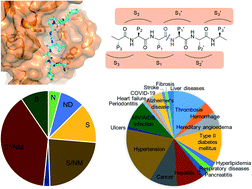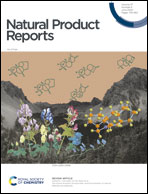Targeting eukaryotic proteases for natural products-based drug development
Abstract
Covering: up to April 2020
Proteases are involved in the regulation of many physiological processes. Their overexpression and dysregulated activity are linked to diseases such as hypertension, diabetes, viral infections, blood clotting disorders, respiratory diseases, and cancer. Therefore, they represent an important class of therapeutic targets. Several protease inhibitors have reached the market and >60% of them are directly related to natural products, even when excluding synthetic natural product mimics. Historically, natural products have been a valuable and validated source of therapeutic agents, as over half of the marketed drugs across targets and diseases are inspired by natural product structures. In the past two decades the number of new protease inhibitors discovered from nature has sharply increased. Additionally, the availability of 3D structural information for proteases has permitted structure-based design and accelerated the synthesis of optimized lead structures with improved potency and selectivity profiles, resulting in some of the most-potent-in-class inhibitors. These discoveries were oftentimes maximized by in-depth biological assessments of lead inhibitors, linking them to a relevant disease state. This review will discuss some of the current and emerging drug targets and their involvement in various disease processes, highlighting selected success stories behind several FDA-approved protease inhibitors that have natural products scaffolds as well as recent selected pharmacologically well-characterized inhibitors derived from marine or terrestrial sources.

- This article is part of the themed collection: Targeting and extending the eukaryotic druggable genome with natural products


 Please wait while we load your content...
Please wait while we load your content...